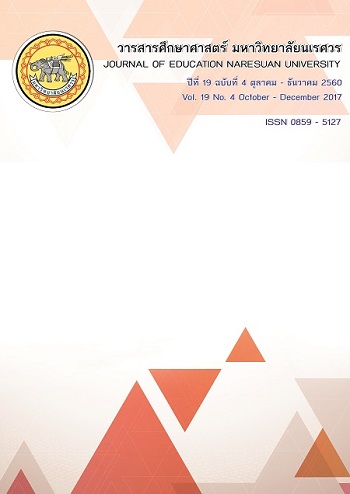TEACHER ROLES FOR SUPPORTING STUDENTS’ GEOMETRIC PROBLEM - SOLVING ABILITIES IN CLASSROOM TAUGHT THROUGH OPEN APPROACH
Main Article Content
Abstract
The purpose of the present research was to study the teacher roles for supporting students’ geometric problem-solving abilities in classroom taught through open approach. This research was employed on the framework of teacher roles in Shimizu’s problem-solving instructional process. The research analyzed data collected from videotape, tape recording class, problem-solving behavior observation, and students’ written work. Data were analytical and present the data through descriptive analysis. The research results showed the teacher roles for supporting students’ geometric problem solving abilities taught through open approach consisted of 1) introduction to problems (Hatsumon); the teacher asks their students question in order to create visualization processes, they can in interpret from situation, 2) observation students’ geometric problem-solving (Kikan-shido); the teacher evaluate how student solve the problem and suggest for them to use the construction process of geometric problem-sloving and take note of them that lead to rearrangement of students’ ideas, 3) classroom discussion (Nariage); the teacher organizes and extends students’ ideas and observes ideas to ask questions in order to create reasoning process in classroom discussion, and 4) summary of key issues (Matome); the teacher reviews students’ geometric problem solving ideas and link them to the conclusion of the lesson.
Article Details
The owner of the article does not copy or violate any of its copyright. If any copyright infringement occurs or prosecution, in any case, the Editorial Board is not involved in all the rights to the owner of the article to be performed.
References
Faikhamta, C. (2013). Self-study research: An alternative professional development strategy for teacher educators. Journal of Education Naresuan University, 15(1), 100-110. (in Thai)
Inprasitha, M. (2010). One Feature of Adaptive Lesson Study in Thailand- Designing Unit. Proceeding of the 45th Korean National Meeting of Mathematics Education.
Inprasitha, M. (2010). Open Approach in Teaching Mathematics. Khon Kaen: Khon Kaen University. (in Thai)
Institute for the Promotion of Teaching Science and Technology. (2007). Learning activity packages to enhance mathematical process skills. Bangkok: Kurusapa Printing Ladphrao. (in Thai)
Isoda, M. (2010). Lesson Study: Problem solving approach in mathematics education as a Japanese Experience. Procedia Social and Behavioral Sciences, 92(11), 17-27.
Panich, W. (2012). Framework for 21st century learning. Bangkok: Sodsri-Saridwongso Foundation. (in Thai)
Polya, G. (1945). How to solve it. Princton: Princeton University Press.
Rutamorn, K. (2014). Introduction to mathematics analysis. Bangkok: Pithak Printing. (in Thai)
Sangpom, W. (2015). Mathematical connections for learner’s knowledge creation. Journal of Education Naresuan University, 16(4), 210-215.
Shimizu, Y. (1999). Aspect of Mathematics teacher education in Japan: Focusing on teacher’ roles. Journal of Mathematics Teacher Education, 2(1), 107-116.
Siriluk, W., Prachanban, P., & Parnichparinchai, T. (2014). Indicators development of student’s skills in the 21st century. Journal of Education Naresuan University, 16(4), 155-165. (in Thai)
Suttiamporn, W. (2015). Mathematical activity emphasized on connection among knowledge and ideas for fostering students’ creativity. Journal of Education Naresuan University, 16(4), 93 -103. (in Thai)


